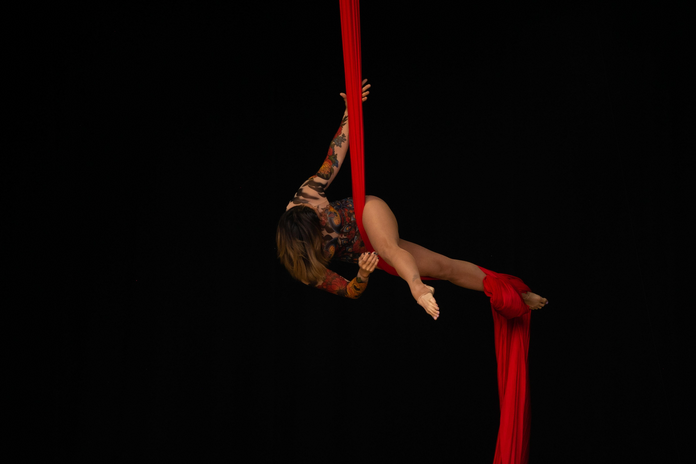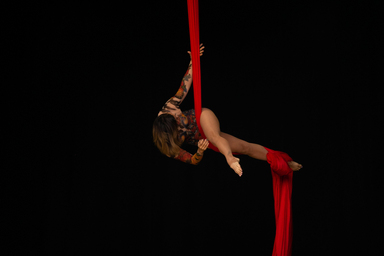“When I perform, I see that everyone has a look that shines. So, I think, everyone wants to do this, right? Why doesn’t everybody do it? We have such a short life, why can’t we experience all these sensations and these emotions?’’.
Whether in Jundiaí, São Paulo, or Reggio Emilia, Italy, Aerial Silk is a crucial part of Karen Agg‘s life. For 18 years, she has been practicing circus art. It went from a hobby, to passion until it became her profession.
The circus is always guided by art, just like Karen’s life.
Passion x Profession
A passion and curiosity led Karen to the practice of aerial silk. “I used to follow the musical group called Teatro Mágico and during their performances, there was always an area dancer. I already liked the music and seeing the music aligned with the movements made me think ‘I want to live this too’’’, she tells. So Karen went for it, and started practicing together with her boyfriend, who is now her husband: “we follow this passion for the circus inside and outside the house’’.
After gathering so much love and experience, she decided to pass on her knowledge by becoming a teacher.
Besides the physical training, aerial silk was important for Karen’s psychology. Through circus practice, she started to work on respecting her own time and listening to her body. “It was then that I really started to fall in love with the art of circus because it is much more a question of working on the psychological side, on being well with you, on respecting yourself than anything else”, she explains.
And this is learning she passes on to her students. “It is very gratifying to see that a student who is afraid, little by little, is gaining confidence in herself. She completes: “I see how important I, as a teacher, am to overcome this process of security. They have to feel safe with the person that is there by their side, guiding them’’.
Aerial Silk in Brazil X Italy

One of them is related to the technical aspects of this art: “In Brazil, the question of technique and strength are very visible, and so is creativity. It is a characteristic that is very typical of us. In Italy, when I arrived here I saw that the way the students developed their activities was very focused on the intimate, on the mystical’’, she explains.
“I observed that they consider this question of the soul a lot. The Italians bring the movements into philosophy. Some teachers even use a little of the Chinese methods during the classes. So, it is all a very, very human part here’’, Karen clarifies. “It is interesting to see how our culture influences acrobatics’’.
Aerial Silk and Psychology: how do they complement each other?
In her post-graduate thesis, Karen and her husband, a psychologist and also a circus teacher, studied how to work through fear during acrobatic activities. “For us, it was very interesting to focus on the fear issue and try to find strategies to work on it, which was what we saw in our daily routine during the classes. What blocks a person is himself in the beginning, this fear, this insecurity. That was a process that we also went through’’. Psychology has a lot to analyze about this behavior and seems to be an important complement to master this art. Why are so many people interested in the circus, but avoid practicing it?
Being on stage
Getting up there, gaining height, and feeling your whole body talk. To begin to pant, to tremble, and to understand all these sensations that come along with aerial silk, for Karen, it’s always a very sensitive and rewarding process.
“Many people think that acrobatic activity is about strength, but it’s not strength, it’s not this physical issue. It is much, more this mental point of overcoming your fears and believing in yourself’’, she concludes.
————————————
The article above was edited by Isadora Noronha Pereira.
Liked this type of content? Check Her Campus Casper Libero’s home page for more!


